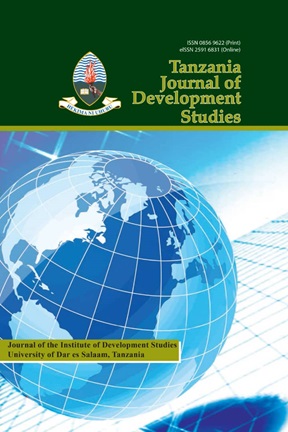Local Resilience to Natural Hazards in Zimbabwe: Experiences from Mhondoro-Ngezi Rural Communities
Keywords:
communities, diversification, livelihoods, subsistence, sustainable, vulnerabilityAbstract
Abstract This article, based on a study carried out in Mhondoro-Ngezi District during the period 2017 to 2019, assesses strategies used by the Mhondoro-Ngezi District rural communities of Zimbabwe to cope with the effects of natural hazards. Rural rapid and participatory appraisal methodologies were used to collect data from 128 members of family units from a regional populace of about 102345. Furthermore, six (6) key informants were contacted for more detailed and nuanced qualitative information. In addition, three focus group discussions (FGDs) were conducted to complement what was obtained from the interviews. In a nutshell, MhondoroNgezi District communities relied on subsistence farming and nutritional gardening for livelihoods. During drought seasons, most households depended on open wells on dry river beds for domestic water use and for watering their gardens. Diversification into activities such as trading and hawking, hunting and gathering wild fruits, brick-moulding, wage labour and artisanal work were noted as means of survival. It was also found out that veld fires and environmental degradation due to human negligence were a considerable challenge in Mhondoro-Ngezi District. The article establishes that some groups in the study communities are more vulnerable to natural hazards than others. The article also proposes measures for mitigating the negative impacts of natural hazards in the study areaReferences
References
Adler, S. P. & S. K. Kwon. (2002). Social Capital: Prospects for a new Concept. Academy of
Management Review, 27: 17 €“40.
Ballesteros, L. F. (2008). What Determines a Disaster? Pesos, Volume 54.
Blaikie, P. T., I. D. Cannon & B. Wisner. (1994). At Risk: Natural Hazards, People's
Vulnerability and Disasters. London: Routledge Publishers.
Burchia, F. & P. Muro. (2016). From food availability to nutritional capabilities: Advancing
food security analysis. Food Policy, 60: 10 €“19.
Carpenter, A. (2013). Social Ties, Space and Resilience: Literature Review of Community Resilience
to Disasters and Constituent Social and Built Environment Factors. Atlanta, GA: Federal
Reserve Bank of Atlanta.
Carter, M. R., P. D. Little, T. Mogues & W. Negatu. (2008). Poverty traps and natural
disasters in Ethiopia and Honduras, World Dev, 35(5): 835 €“56.
Chambers, R. & G. Conway. (1992). Sustainable Rural livelihoods: Practical Concepts for
the 21st Century. Ecology and Society, 11(1): 2. Discussion Paper 296, Brighton: IDS.
Creswell, J. W. (2014). Research Design: Qualitative, Quantitative and Mixed Methods
Approaches. California: Sage Publications.
Deli, F. (2011). Opportunity and Necessity Entrepreneurship: Local Unemployment and
the Small Firm Effect. Journal of Management Policy and Practice, 12(4): 39.
Donner, W. & H. Rodriguez. (2011). Disaster Risk and Vulnerability: The Role and Impact of
Population and Society. Washington DC: Population Reference Bureau.
Dube, E. (2016). Improving Disaster Risk Reduction Capacity of District Civil Protection Units in
Managing Veldt Fires, Bulawayo, Zimbabwe.
Food and Agricultural Organization. (2017). Zimbabwe's Natural Regions and Farming
Systems.
Gross, S. R. (2012). Exonerations in the United States, 1989 €“ 2012, Report by the National Registry
of Exonerations, University of Michigan Law School.
Helmore, G. & N. Singh. (2001). Sustainable Livelihoods: Building on the Wealth of the Poor,
Bloomfield, Kumarian Press.
Hemingway, L. & M. Priestley. (2008). Natural Hazards, Human Vulnerability and Disabling
Societies: A Disaster for Disabled People? Centre for Disability Studies, University of Leeds (UK).
Levin, R. & D. Weiner, (eds.) (1997). No More Tears: Struggles for Land in Mpumalanga, South
Africa. New Jersey: Africa World Press.
Mapira, J. (2011). Urban Governance and Mismanagement: An Environmental Crisis in
Zimbabwe. Journal of Sustainable Development in Africa, 13(6): 258-267.
Mashizha, T. M., N. Monga & M. A. Dzvimbo. (2017). Improving Livelihoods of Resettled
Farmers through Development of a Knowledge Base on Climate Change in Mhondoro €“
Ngezi District, Zimbabwe. International Journal of Sustainable Development Research, 3(2):
(18 €“26).
Mugumbate, J. (2014). Persons with Disabilities in Zimbabwe, Department of Social Work,
Bindura University Press.
Niboye, E. P. & Ngwaru, F. (2020). The Need of Linking Local Community and National
Disaster Risk Reduction Strategies for Effective Disaster Mitigation: Lessons from
Zimbabwe. Research on Humanities and Social Sciences. www.iiste.org ISSN 2224-5766
(Paper) ISSN 2225-0484 (Online), 10(2): 2020.
Rufata, S., E. Tate, C. G. Burton & A. S. Maroof. (2015). Social Vulnerability to Floods:
Review of Case Studies and Implications for Measurement. International Journal of
Disaster Risk Reduction, 14(4): 470-486.
Twigg, J. (2001). Sustainable Livelihoods and Vulnerability to Disasters: Disaster Studies Working
Paper 2, Benfield Greig Hazard Research Centre.
Wisner, B., P. Blaike, T. Cannon & I. Davis. (2004). At Risk: Natural Hazards, People ' s
Vulnerability and Disasters, 2nd edition. London: Routledge


